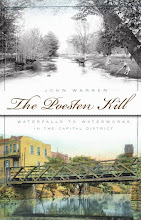 Between the more formidable island of Papscanee (previously spelled Papsickene, now a peninsula nature preserve) and where the Hoosac River meets the Hudson, more than a dozen streams flow into the Hudson. Only at the Poesten Kill was there enough farmland, room to grow, and sufficient water-power for the earliest industries.
Between the more formidable island of Papscanee (previously spelled Papsickene, now a peninsula nature preserve) and where the Hoosac River meets the Hudson, more than a dozen streams flow into the Hudson. Only at the Poesten Kill was there enough farmland, room to grow, and sufficient water-power for the earliest industries.
An early outlying farm built across the Hudson River from Fort Orange was built by 1632 on the south side of Mill Creek at de Laetsburgh, later known as t’greynen bosch (Greenbush, the pine woods) and now within the Rensselaer city limits. Like the Poesten Kill it also had mills, homes, a brewery and tavern, and even a Dutch Reformed church and parsonage. A ferry was established there and later colonial soldiers were often mustered under the protective eye of the fort across the river. The ferry continued to be controlled by the Van Rensselaer family until the nineteenth century providing easy and regular transportation between the Greenbush and Albany.
South of Fort Orange, on the Hudson's west side, flooding and terrain restricted development of farms and the Normanskill was insufficient as a source of power.
Four miles north of Fort Orange on the Hudson’s west side the Patroon established a farm once called de Vlackte (the Flatts, home of the Patroon’s agent Arent van Curler), later known as West Troy and today Watervliet. The farm was considerably closer to the fort than those on the Poesten Kill and much more connected to life there, but lacked water power.
Photo: The Hudson River Valley c 1635
Monday, September 28, 2009
Other Early Settlements Along The Upper Hudson
Labels:
City of Renssealer,
Fort Orange,
Greenbush,
Hudson River,
Watervliet
Subscribe to:
Post Comments (Atom)

No comments:
Post a Comment